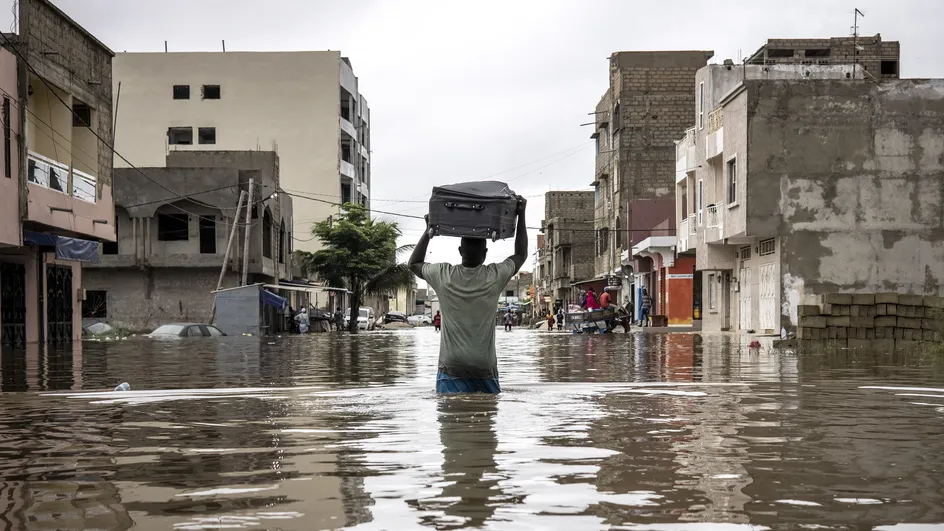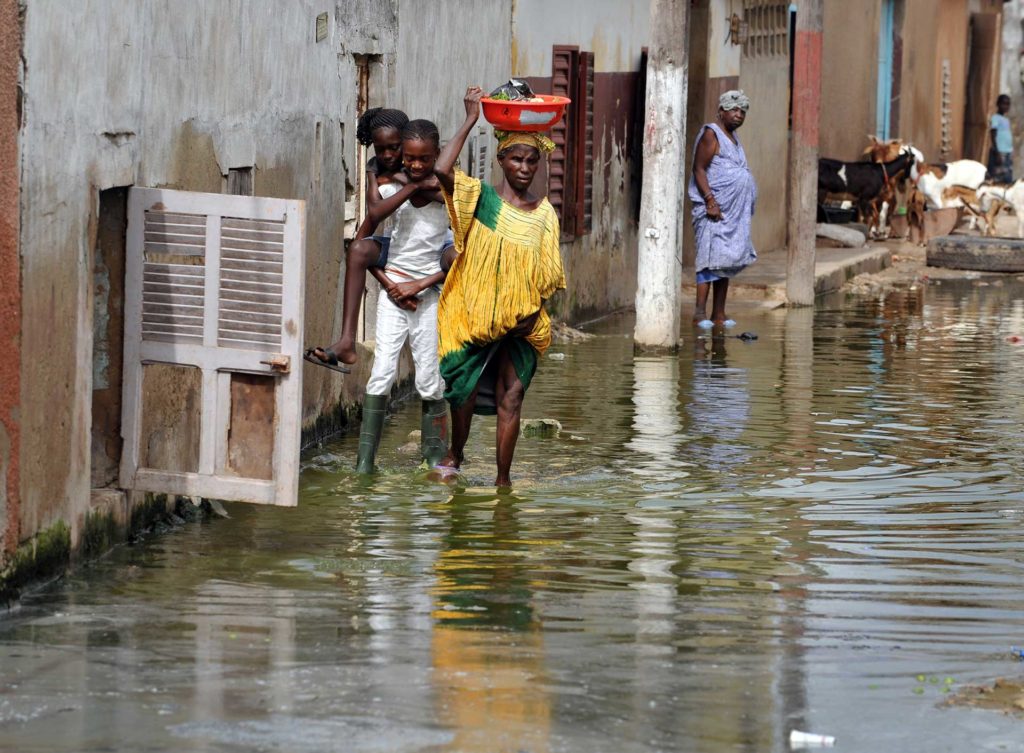The populations of the poor districts of Dakar, first victims of the floods
For several decades, floods on the Cape Verde peninsula have prevented the inhabitants from sleeping. They occur every year during the rainy season, from June to October, leaving behind deteriorated and unhealthy neighborhoods. This long-lasting phenomenon has been intensifying for recent years with waters rising higher and higher and new neighborhoods being affected. There is no boundary for floods: they affect households as well as stores, schools, hospitals and public agencies. Without proper drainage facilities, the water will spread until natural drainage takes place. In 2019, only 5 classrooms out of 15 in the commune of Sam Sam were usable after the flood. In Diamaguène Sicap Mbao, one of the most affected communes in the last ten years, out of the 79 neighborhoods in the commune, only 5 were spared by the water. In addition to material damage, flooding also poses a risk to people and local sanitary conditions. In September 2020, an unconscious body was found in Guinaw-Rails after the waters came down. Moreover, since there is no sewage system, all the water is discharged disorderly on the streets or in uninhabited areas. The stagnation of dirty water and muddy land leads to serious sanitation problems. The sludge often has to be removed manually despite the health risks. In many neighborhoods, the streets are strewn with typhas, a sign of the sogginess of the soil that persists long after the surface water has run off. In the end, the affected households have to live in damp and unsanitary dwellings because of the financial precarity after the disaster. pen

While many residents have mentioned a lack of political will to deal with the situation, it seems that local authorities are overwhelmed by the intensity and scope of the phenomenon. Thus, despite the fact that their range of competencies has grown considerably since the decentralization of the Senegalese government, their technical, material and financial resources remain weak. The authorities’ response is often the same and involves identifying the needs so that concrete actions can be taken. However, every year, in some neighborhoods, the residents see their elected officials overwhelmed, walking on the streets where the prevention facilities are being set up, and making speeches full of promises that seem difficult to keep. Moreover, the decentralization of competences related to flood response has entailed inequalities between neighborhoods. Thanks to the installation of private companies, some neighborhoods are equipped with more resources and special technical skills, and thus manage to cope with the phenomenon and even contain it. In other communes with more fragile finances, the sense of powerlessness of local authorities is reflected in actions such as that of the municipality of Diamaguène Sicap Mbao, which in 2019 bought sandbags of more than 20 million CFA francs to limit the advance of water, failing to be able to build suitable facilities. In the emergency, the authorities have also resorted to the use of flexible pipes to redirect water to other channels without really knowing how much water they can accommodate. Faced with ineffective measures, residents must act on their own to try to save their homes or businesses. However, the motorized pumps used to vacuum up the stagnant water are expensive and can be suddenly taken by floods. Given the discontent of the population, some communes prefer to prevent by calling in the police during these events. This strategy fuels a vicious circle of insecurity in the affected areas.
Infrastructures that barely limit the magnitude of the floods
Faced with this critical situation, in 2012, after being elected as president of the country, Macky Sall launched the Ten-Year Flood Management Program (PDGI), which succeeds the JAXAAY plan put in place after the terrible floods of 2005. It is a comprehensive plan that covers all levels of governance in the country. In 2021, according to the Ministry of Finance, nearly 511 billion CFA francs (780 million euros) were spent under the program. The PDGI was designed to be implemented from 2012 to 2022 with a budget of 750 billion CFA francs. It foresaw a technical study of the flood zones, the relocation of affected populations, and the planning and development of cities, including drainage channels and gutters. In 2018, 65 kilometers of drainage canals were built as well as a dozen pumping stations and 20 retention basins at a cost of about 149 billion CFA francs, according to the National Sanitation Office of Senegal. But the rains continue to fall. And while some residents have seen clear improvements in their neighborhoods, such as in Mariste and Ouest Foire, others still have their feet in the water every year. A crucial component of the PDGI is the Stormwater Management Program (PROGEP) initiated in 2012, which is managed by the Municipal Development Agency (ADM). Nevertheless, the confusion between these two programs shows the lack of information and communication between the different levels of authorities and the population. Prior to the rainy season of 2021, as part of PROGEP 1, canals had been built and lakes in the Mbao forest had been rehabilitated. The facilities, whose quality was praised by the Minister of Local Government, Development and Land Use Planning, gave way to flooding a few weeks later. Several facilities that were supposed to guarantee the effectiveness had not been built and the technical study was very basic. In response to these deficiencies, the ADM has announced the construction of several water drainage basins within the framework of PROGEP 2. However, these installations will not be operational for several more years and will require the displacement of many inhabitants. The PROGEP 2 is presented as a new version of the program that would correct these errors and take into account a wider range of areas damaged by the floods.

The intensification of the flooding in recent years is in part due to the climate change, according to the statements of many elected officials. Nevertheless, it is mainly linked to the poor management of urban development and construction on the peninsula. Indeed, no controls or regulations are enforced by the local authorities. Areas that should not be developed because of the known risk of flooding, undergo wild construction. Building permits and technical studies are not requested. This is compounded by the non-existence of sewage and drainage systems, which creates high risks. Thus, where water could naturally flow before, it now faces a wall of bricks or debris. For example, during the construction of the VDN3 in Guédiawaye, the pre-existing drainage canals were damaged or destroyed, which subsequently aggravated the flooding phenomenon in the area. Another example is the water of Mbao marigot, which receive water flows from Keur Massar, a region regularly affected by major floods, and is listed under the Ten-Year Flood Management Program (PDGI). It is now surrounded by unregulated wildlife habitat and the bed is filled with trash. No maintenance initiatives have been put in place.
Technical cooperation for a better understanding of floods
Therefore, these initiatives are strongly compromised by several problems. First, while the construction of pumping stations and drainage canals is necessary, these initiatives, which are costly, do not provide a sustainable solution to the problem. More comprehensive and larger-scale infrastructure planning is required. In addition, the facilities and infrastructures that are built are all constructed individually, whereas they need to be designed and work in synergy to be effective. Decentralization has only pushed neighborhoods further apart, leaving room for insufficient coordination and mutual aid in the fight against the flood. The authorities often give in to the emergency and ignore technical studies, which are costly and time-consuming in the context of scarcity of professionals. Nevertheless, they remain essential to devise adequate infrastructures and intervene effectively. Thus, it would seem that the Senegalese authorities need to detach themselves from a welfare state strategy and turn instead to partners who can support them in their fight against flooding. Be it NGOs, private companies or international institutions, many actors can support the initiatives of local actors by providing technical expertise and experience in flood management.
Écrit par Paola Hernandez
Traduit par Xiaosu Wang
